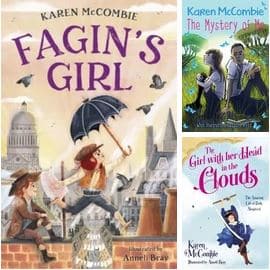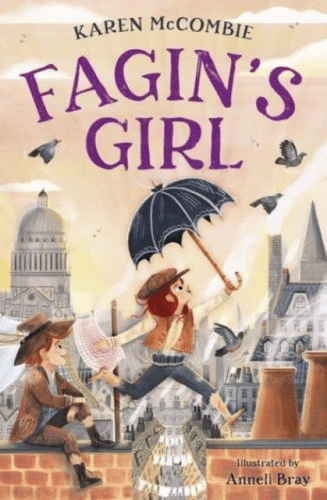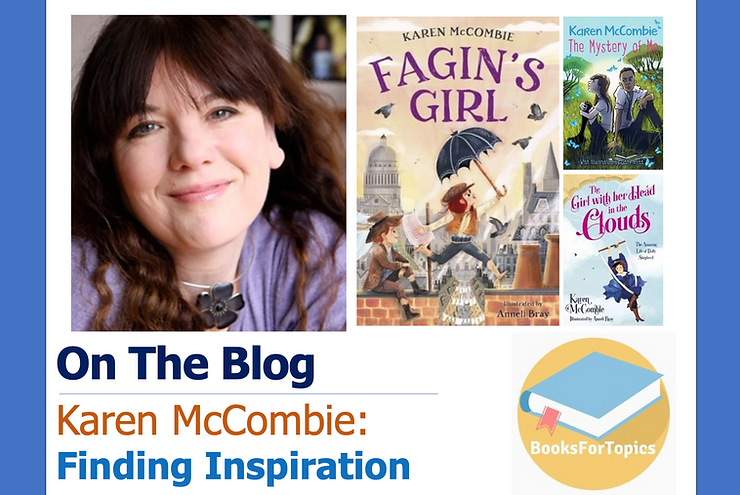Karen McCombie is the author of many books for children and teenagers, with her 100th due to be published in 2023. Many BooksForTopics readers will recognise Karen’s titles scattered among our booklists, from Little Bird Flies and Little Bird Lands on the Limb Difference and USA topic booklists respectively, to The Pearl in the Attic on our Books for Fans of Jacqueline Wilson list, to The Lost Diary of Sami Star on our Year 5/6 Reluctant Readers booklist.
One of Karen’s most recent books is Fagin’s Girl, offering an alternative perspective on Oliver Twist and following a girl who disguises herself as a boy so that she can join Fagin’s gang of pickpockets. Fagin’s Girl is available to purchase online from Amazon or from Bookshop.org.
This week, Karen stopped by our blog to share her insights into finding story inspiration based on her most recent books with Barrington Stoke…
Guest Post:
Nosyness, ‘what-if?’s and sofa-slouching… Karen McCombie’s non-glamorous tips for finding inspiration!

I love the Q&A section of my school visit talks. It’s the point where it becomes more of a conversation than a presentation, and the questions from students are always entertaining!
But once upon a school visit, I heard a statement rather than a question when I pointed to a boy with his hand up.
“I don’t think I can do inspiration,” he said.
That really stuck with me, and as a result, I ended up tweaking future talks so that I now always try to assure young people that they absolutely can ‘do’ inspiration; it isn’t some awesome magic trick that only authors can conjure up. In other words, I lift aside the curtain and show & tell the stories behind the stories in my books.
I talk about the memories I’ve recycled from my old school diaries, the small-but-funny anecdotes my friends and family have shared with me over the years, the silly things my pets have got up to, the photos I’ve snapped of interesting things and places. All the random, quirky stuff collected in my notebooks, camera roll and brain like I’m some human-sized magpie. I hoard all these moments and memories and use them to bring my stories to life.
Most of all I like to surprise students by talking about three incredibly useful inspiration prompts: nosyness, ‘what-if?’s and sofa-slouching!
Nosyness – it’s a crucial talent to foster when you’re an author. For example, one rainy Sunday I went on a tour of Alexandra Palace, a local landmark near where I live. During his talk, the guide made a passing mention of 16-year-old Dolly Shepherd, who back in 1904 shocked crowds by leaping out of a hot air balloon above the Palace, with only the flimsiest parachute and virtually no training. My natural nosyness made me want to know more, and I went on to Google Dolly. I discovered a treasure trove of tales about her adventures in the skies, of her bravery and close shaves! I was desperate for more people to know about this incredible young person, and retold her story in ‘The Girl With Her Head In The Clouds’.
 As for ‘what-if?’, that’s a game we authors certainly enjoy playing. Here’s what happened after my kid came back from a school geography trip… I asked how it went, and Eddy answered, “Everyone on the coach home was mucking around and the teachers went mad at us”. Eddy wandered off, but I started thinking about that noisy, chaotic coach full of students. What if there was a similar, fictional coach trip, and the driver became distracted by the boisterous behaviour? What if there was an accident? What if everyone came out with just bruises, except one girl, who ends up with a head injury and memory loss? What if I write a story about that, with the girl finding out more about herself than she anticipates? Soon after, this game of ‘what-if?’ developed into ‘The Mystery of Me’.
As for ‘what-if?’, that’s a game we authors certainly enjoy playing. Here’s what happened after my kid came back from a school geography trip… I asked how it went, and Eddy answered, “Everyone on the coach home was mucking around and the teachers went mad at us”. Eddy wandered off, but I started thinking about that noisy, chaotic coach full of students. What if there was a similar, fictional coach trip, and the driver became distracted by the boisterous behaviour? What if there was an accident? What if everyone came out with just bruises, except one girl, who ends up with a head injury and memory loss? What if I write a story about that, with the girl finding out more about herself than she anticipates? Soon after, this game of ‘what-if?’ developed into ‘The Mystery of Me’.
And then there’s sofa-slouching; in other words, kicking back and looking at screens. You can always hear the audience gasp when I say this, as if telly shows, films, TikToks and gaming are simply about switching off. But if you’re enjoying the story-telling element of what’s in front of you, of course it can spark ideas! And ‘Fagin’s Girl’ – my nod to Charles Dicken’s infamous pickpocketing gang – came about because me and my 20-year-old were having a weekend of watching old childhood film favourites. The musical ‘Oliver!’ was one of them, and its storyline lingered in my head afterwards, eventually morphing into the idea of a destitute young girl disguising herself as a boy to join the relative safety of the infamous Victorian gang. My version of the story is very different, pitched before the time of Oliver and the Artful Dodger, and has a surprise final chapter set two centuries into the future. But if I hadn’t slouched on that sofa with a hot chocolate one autumn afternoon, if me and my kid hadn’t indulged ourselves in a nostalgic old movie, ‘Fagin’s Girl’ wouldn’t have existed!
And right now, it’s time to dream up a new book idea. So for the next few days you’ll find me flicking through my notebooks, scrolling through my photos, nosying around and playing ‘what-if?’. But first I might just put the TV on and have a quick search around… who knows what gems of inspiration I might find lurking in amongst the schedules and box-sets!
———————

Fagin’s Girl is available to purchase online from Amazon or from Bookshop.org.
Many thanks to Karen for swinging by and sharing her tips!
———————
Where next?
> Visit our Reading for Pleasure Hub
> Browse our Topic Booklists
> View our printable year group booklists.
> See our Books of the Month.









